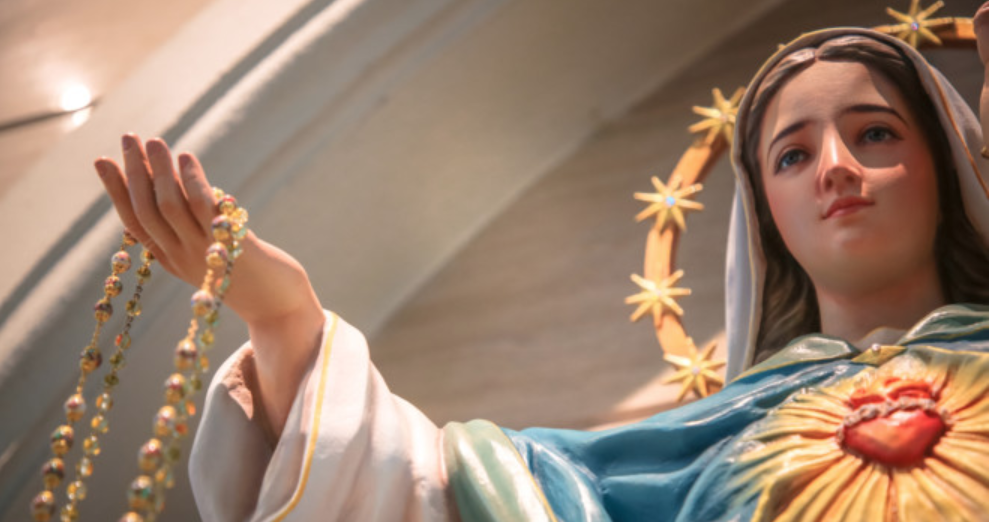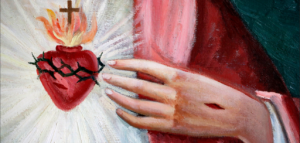
IMMACULATE HEART OF MARY – PRACTICAL ADVICE

When it comes to our relationship with the Blessed Mother, it is valuable for our own prayer life to see how the liturgical celebration of the Immaculate Heart has been presented to us, and to see how the changes over the years can help us to deepen our prayer life.
1. Born from the Scriptures. Devotion to the Immaculate Heart of Mary has a clear home in the Gospels: Luke 2.19 has Mary pondering all the wonders of the incarnation “in her heart” and Luke 2.22-40, has the other side, especially verse 35 “and a sword shall pierce your own soul too.”
In Christian iconography the Immaculate Heart – the actual heart – is depicted as crowned with roses, normally aflame with the love for God, and often, but not always, shown with a sword piercing through. Knowing what Mary went through, this all makes sense.
2. Devotion to a historical person and real events. The celebration of the Immaculate Heart has moved around the calendar a fair bit, but before the most recent reform of the calendar, it was celebrated on August 22, the octave of the Assumption of the Blessed Virgin. This allowed devotion to the heart of Mary to be closely linked to her glorious state, brought to the throne of God. So when we pray with Mary or the saints, we are not making this up. These are real people who continue to seek a real relationship with us as much as we seek them.
3. Devotion to Christ. Something interesting happened when the calendar was renewed. The devotion to the Immaculate heart was tied to the feast of the Most Sacred Heart, and was reduced from a double of the second class (essentially a feast) to a memorial. This was an important change, a realization that our devotion to Mary and her Immaculate Heart only makes sense in relation to our love for Jesus and the Sacred Heart.
There is an interesting give and take in our relationship with God. The Father can seem so distant, so we pray “through Christ our Lord” or we pray in the Holy Spirit. Then, as time went on, Jesus became almost as remote as the Father, and so we focused on Mary and the Saints to intercede for us. Do not misinterpret me here, the reason we can and should pray in this way is that it works. God hears us when we pray in company, but what the change to this memorial shows is that any devotion needs to be related to our devotion to Christ, to God.
4. Prayer for oneself. The prayers for the liturgy on this day ask for Mary’s intercession so that we might “glory in the fullness of your grace….” This and other prayers like it help me to get over an impediment I had in prayer as a child. It is completely appropriate and not at all selfish to pray for yourself. Praying for ourselves allows us to put ourselves in a relationship with the Blessed Mother and the saints, but it is also a commitment on our part to be dedicated to living a life worthy of that relationship. So asking for something for myself is essential if I hope to grow in that relationship and come to know how to live the life of the reign of God.
5. Prayer for others. For this part I went on line and was mostly glad to see that the devotional prayers to the Immaculate Heart promote this prayer relationship as part of our prayer for the whole world. Yes, pray for your own needs. No, never make it just about you and Jesus, let alone you and Mary. We have the power of prayer, and so we should use it for the sake of all.
6. Things to avoid. In my little booklet, Like Spokes on a Wheel: Catholic Prayers beyond the Liturgy, I talk a fair bit about devotions and prayers, and among the things I mention that we should avoid prayers that offer “impossible guarantees…or claims a revelation that goes against the gospels.” There are prayer forms, especially those where you have to do certain things on certain days, that have a magical feel to them. The point of our devotion to the Immaculate Heart is not that we have a direct line to get what we want. Rather it is a way for us to share what we have been given.
If following these 6 pieces of advice can help you in your relationship with the Immaculate Heart of Mary, it can also be applied to any of the saints. If your favourite saint isn’t from the Bible, adapt that first point to finding a virtue in the Scriptures that matches the core virtue of your saint, and you are good to go.
Prayer is such a great thing. Praying with the saints can be a great way to see our place in God’s plan. If this is old hat for you, today is a great day to renew our devotion. If praying with the saints is new, give it a try!
Glenn Byer has been making music for the Mass for 40 years, and has been writing about and offering courses and workshops on liturgy for more than 30 years. He holds a Master’s in liturgy from the University of Notre Dame and a doctorate in liturgy from the Pontifical Institute for Liturgy at the Atheneaum of Sant’Anselmo in Rome. Glenn has written numerous books, among them: 26 Ordinary Ways to Live the Liturgy, Unlocking the Feasts and Seasons of the Liturgical Year and Living the Liturgy of the Word.

